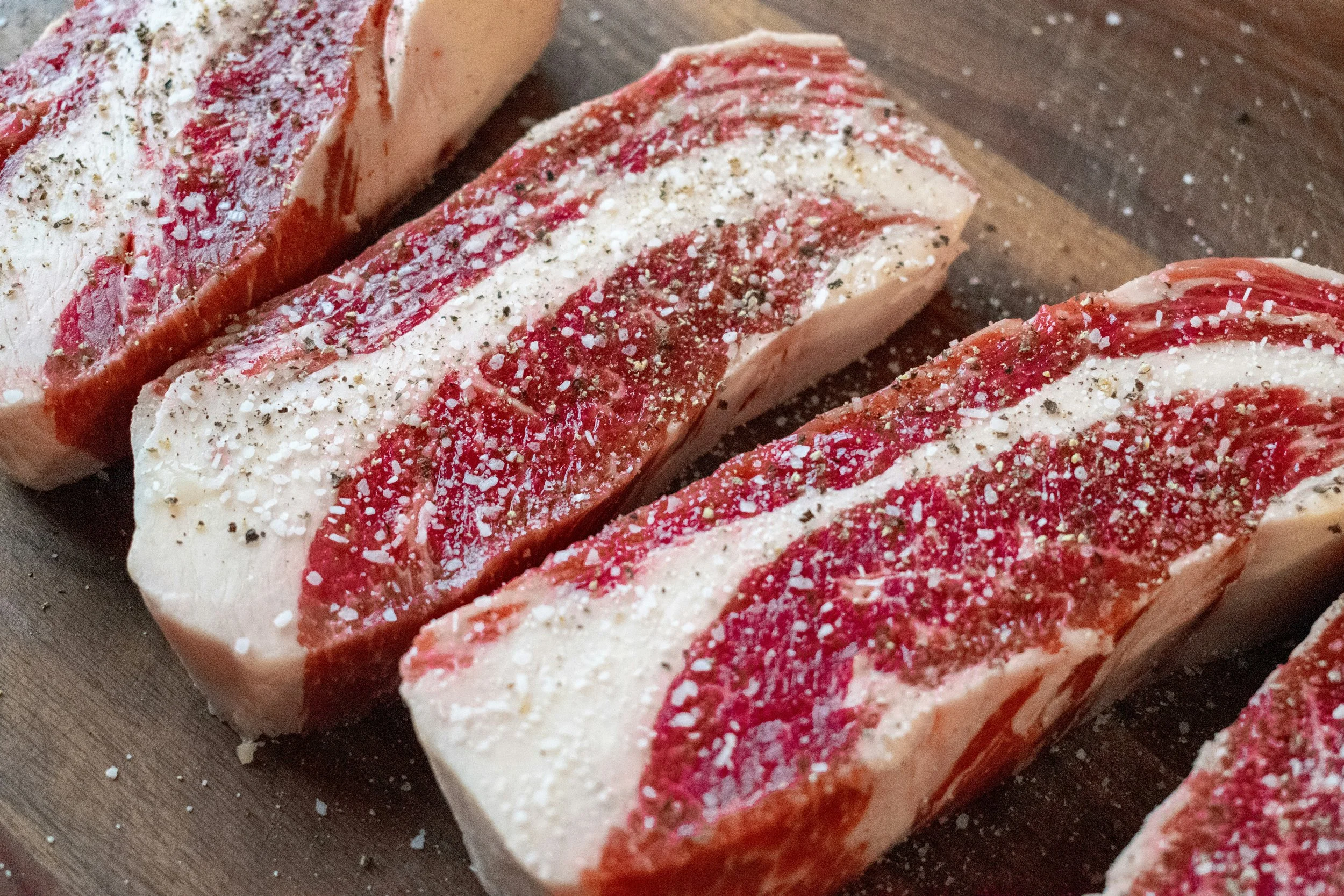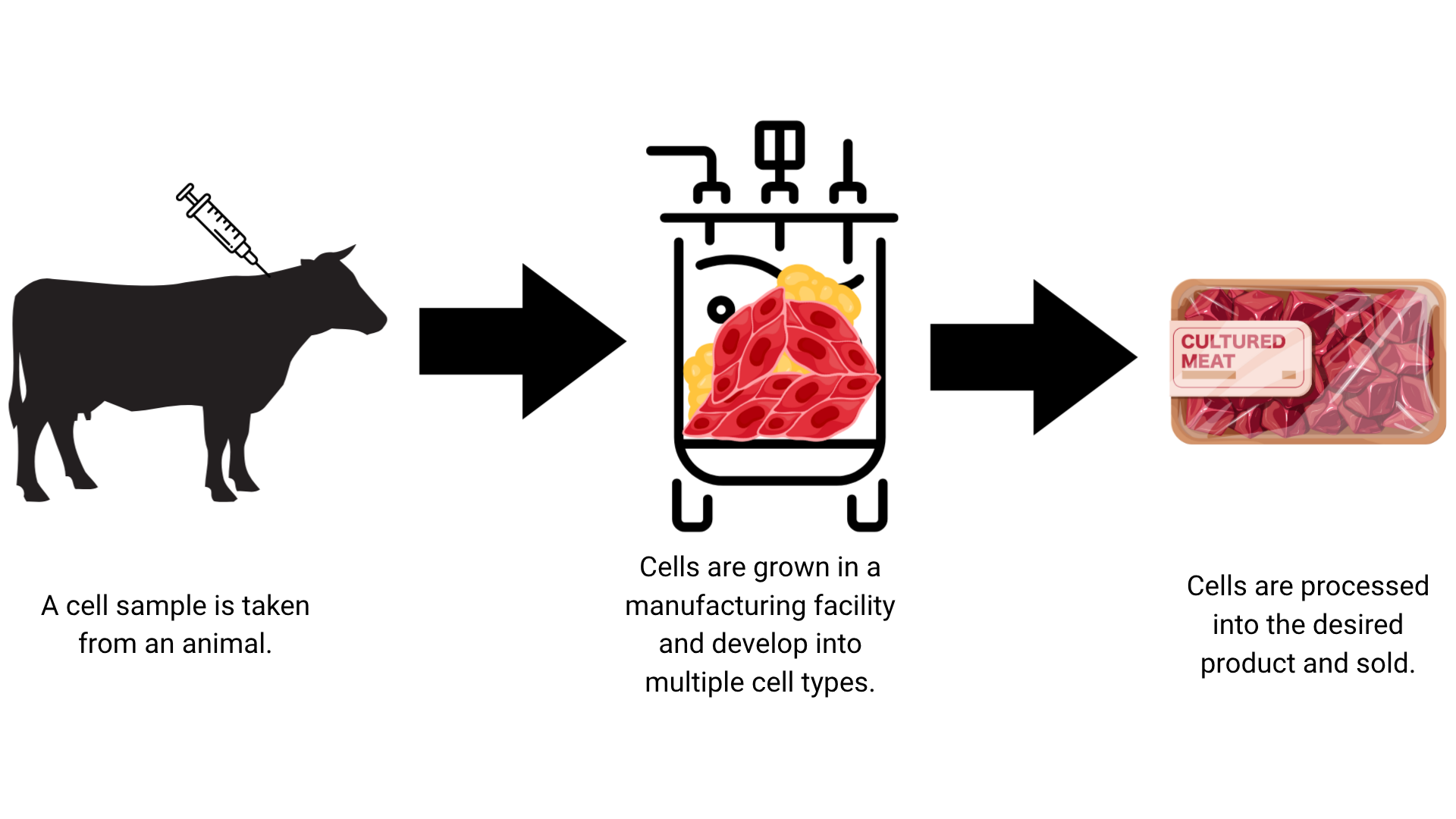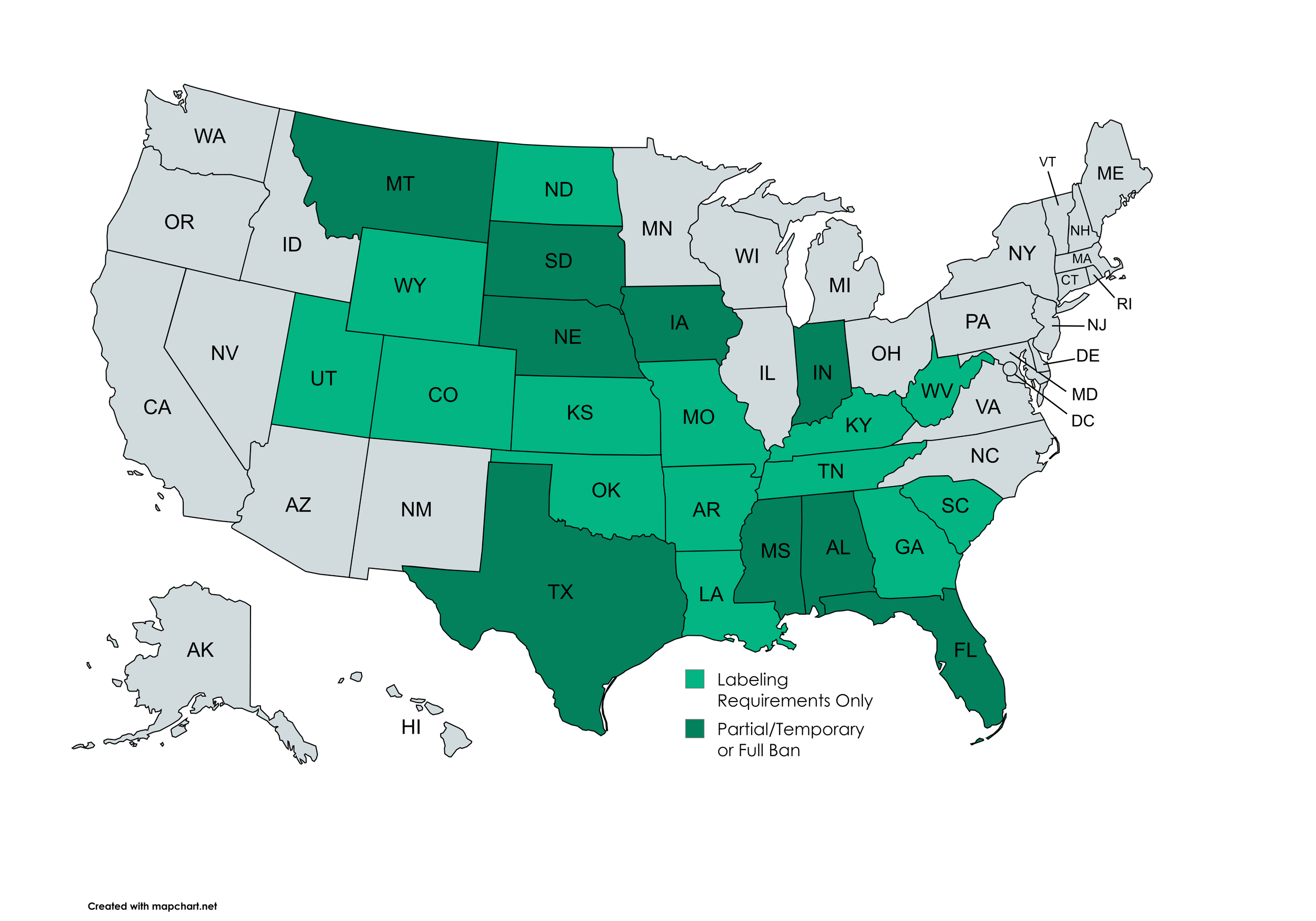
Lab-Grown Meat in West Virginia
This Science & Technology Note provides information on the production of lab-grown meat, benefits and drawbacks compared to traditionally-produced meat, and an overview of regulations, both within West Virginia and nationally.
Research Highlights
With continued technological advances, lab-grown meat could be more environmentally friendly, safer, and cheaper than traditional meat.
Expanded production of lab-grown meat could majorly disrupt West Virginia’s existing agricultural economy.
West Virginia introduced labeling requirements for lab-grown meat in 2024. Many states have similar measures, but some have taken further regulatory action.
Meat is a source of dietary protein for many people, with global consumption predicted to grow 14% over the next decade. However, some are concerned about the use of traditional agriculture and meat production practices to meet this need, as they are resource-intensive. Alternative protein sources, including lab-grown meat, have been proposed as new alternatives to traditional meat.
Production of Lab-Grown Meat
Plant-based, insect-based, and lab-grown meats are all types of alternative protein sources. Of these, lab-grown meat has been subjected to the most debate. Lab-grown chicken was first approved for sale in Singapore in 2020, and was approved in the US in 2023. Since then, it has been served at 2 restaurants in the US, and this summer, lab-grown salmon was added to some restaurant menus. Although some products have received approval for sale, lab-grown meat products are not widely available in the US due to the variety of restrictions on the products that different states have implemented.
To produce lab-grown meat, a sample of cells is taken from an animal, most commonly chickens, cows, pigs, or seafood. Each sample may be used to produce several batches of meat. The collected cells are grown in large vats called bioreactors and develop into muscle cells, fat cells, and connective tissue. Cells are grown on artificial scaffolding to help them grow into structured sheets before they can be processed into their final form and sold. The whole process typically takes several weeks. Before these products can be sold in the US, they must undergo an initial safety review by the FDA and ongoing inspections through the Food Safety and Inspection Service.
To produce lab-grown meat, a sample of cells is taken from an animal to develop into muscle, fat, and connective tissue. The cells are then shaped, processed, packaged, and sold.
Considerations for Lab-Grown Meat
Lab-grown meat advocates often tout its assumed smaller environmental impact due to reduced land and water use as a reason to adopt the technology. Lab-grown meat is estimated to utilize 1/6 of the amount of water compared to traditional meat and 1/100 of the amount of land. Recent research shows that while land and water use may be reduced, lab-grown meat is more energy intensive and may produce more damaging greenhouse gases (depending on how energy is produced) than traditional meat. However, these impacts could be reduced with continued technological innovation to scale up processes and utilize more environmentally friendly raw materials. Lab-grown meat could reduce the risk of foodborne illness, as it is produced in sterile environments, and it may decrease the risk of illnesses that can spread from animals to people. Lab-grown meat could also reduce antibiotics used in livestock, lowering the risk of antimicrobial resistance.
More than 150 companies are involved in the development of lab-grown meat, and have benefited from heavy investments in the area over the recent years. Predictions from the consulting firm McKinsey estimate that the lab-grown meat market could reach $5-25 million by 2030, and expansion of lab-grown meat could bring with it well-paid manufacturing jobs, potentially to West Virginia. Although the alternative protein market seems to have large opportunities, it could negatively affect other industries in the state.
West Virginia’s agricultural economy is predominantly animal-based, making up 78% of the state’s agricultural income and almost 2% of the state’s economy. 4 out of the 10 highest-grossing agricultural commodities in the state are meat. In a series of interviews, farmers shared concerns that lab-grown meat could affect the availability of non-food livestock products such as leather and pet food, or could harm the wider rural economy by reducing the need for veterinarians, farm equipment suppliers, and animal caretakers. Although lab-grown meat production could bring new job opportunities to the state, these jobs would require different training and skill sets than traditional agricultural jobs. Advocates of lab-grown meat counter by saying that the industry could provide new opportunities for farmers through creating the view that traditional meats are ‘special’ and increasing their value.
Lab-grown meat companies have a long way to go in reaching widespread uptake of their products. 60-80% of consumers are unaware of lab-grown meat. Of those who are aware of the products, many are uninterested in purchasing or consuming lab-grown meat, with less than 20% of US adults expressing willingness to purchase a lab-grown meat product. Reasons often cited for a lack of interest in lab-grown meat include a lack of understanding, thinking the products aren’t safe, healthy, or natural, disliking the taste or texture, the high cost, and wanting to support farmers. Of the consumers who are interested in lab-grown meat, improved ethics and animal treatment over traditional agriculture is the most cited reason for trying the product. An additional barrier to widespread adoption of lab-grown meats is their cost. Recent advances in the industry have brought production costs to around $200 per pound of beef, but future estimates are around $20 per pound. For comparison, traditional beef production costs are roughly $2.50 per pound. Startup costs remain high as well, estimated to range from $300-600 million. High costs raise the concern that lab-grown meat may further contribute to the industrialization of food systems.
State Regulation of Lab-Grown Meat
Over the past 2 years, West Virginia has introduced legislation both to impose labeling requirements for lab-grown meat and to ban the products. HB 5349 passed in 2024, requiring lab-grown meat products to clearly state this on their labels. SB 582, which aimed to implement a full ban on lab-grown meats, was also introduced in 2024, but did not pass. The 2025 legislative session saw the proposal of SB 185 and SB 751, which would have modified the established labeling requirements for lab-grown meat products by requiring a list of all ingredients in the product and temporarily banning the products until 2030 with exceptions for research, respectively. Neither bill passed out of committee.
Some states are interested in the potential of lab-grown meat. Illinois established the Alternative Protein Innovation Task Force in 2023, designed to evaluate opportunities for the industry. They recently released their report containing recommendations for supporting the alternative protein industry. However, many states are taking a more cautious approach to lab-grown meat. In 2024, Florida and Alabama banned lab-grown meat, with additional states following suit in 2025. Two of these bans only last until 2027, allowing more time for the field to advance. Nebraska prohibits state agencies from purchasing lab-grown meat, while Iowa banned lab-grown meat in schools. Tennessee established a permitting process to sell lab-grown meat, and Utah requires restaurants serving it to notify the state. Most states with bans also have labeling restrictions in place. 21 states have established additional labeling laws to ensure clarity for customers. At the federal level, labeling requirements for lab-grown meat have been proposed, but not passed. Lab-grown meat companies have pushed back on labeling requirements and bans, with ongoing lawsuits in Florida and Texas alleging infringement upon interstate commerce. If West Virginia moves forward with a ban on lab-grown meats like those that have been proposed, the state should be mindful of the potential for similar lawsuits.
States have a variety of regulations on lab-grown meat. Light green states have labeling requirements only, and dark green states have some form of ban.
This Science and Technology Note was prepared by Madison Flory, PhD, West Virginia Science & Technology Policy Fellow on behalf of the West Virginia Science and Technology Policy (WV STeP) Initiative. The WV STeP Initiative provides nonpartisan research and information to members of the West Virginia Legislature. This Note is intended for informational purposes only and does not indicate support or opposition to a particular bill or policy approach. Please contact info@wvstep.org for more information.

